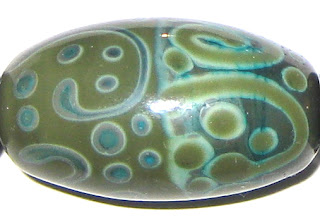1 - Plain, 2 - Plain (reduced), 3 - w/ Silver Leaf, 4 - w/ Silver Leaf (reduced & encased), 5 - w/ TerraNova2 Frit, 6 - w/ Silver Glass Frit Blend (reduced), 7 - w/ Tuxedo, 8 - w/ Copper Green, 9 - w/ Opal Yellow, 10 - w/ Ivory, 11 - w/ White
General Impressions
CiM Ming is a medium, translucent blue. By itself, it's quite a bit brighter than I'd normally like, and it's a very 'webby' colour. It's also pretty shocky. Not as shocky as Anise White or some of the Vetrofond odds, but definitely shockier than I would prefer.
Some of the redeeming features of Ming are how interestingly it reacts with other colours, and how it can be applied in a thin layer and lose some of its crazy brightness in ways that just aren't possible with other blues of similar hue. The reactions that are possible with Ming are pretty interesting, and I haven't ever seen some of them before which was kind've thrilling.
Reactions
With silver leaf on its own, Ming just lets it vein through without much in the way of a reaction. You can see the veins of silver in the bead on the left. However, if you reduce and encase that silver, you get the wild, webby, crazy, shiny reaction we see in the bead on the right. I really like this reaction.
In the bead on the left, the TerraNova2 frit has struck nicely, but more in the blue and purple ranges that make it not stand out so well against the Ming. In the bead on the right, some of the bits of frit have developed an interesting halo around them. I need to do a little more testing with Ming and Silver Glass. The other interesting thing about these two beads is that the Ming has lost some of its harshness and some of its translucency and become a more milky blue.
With Tuxedo, the cloudy marbling in the ming is mild, but there is some curdling of the surface of the colour. The Tuxedo dots and lines look fairly crisp on the Ming though, unlike what happens in the beads below.
Over Copper Green, Ming thins out to almost nothing, looks completely transparent and really befuddles the surface of the Copper Green. It develops light turquoise halos around it and odd, grainy veins of Ming concentrate in the surface of the dots and lines of the stringerwork that remind me of cracks in cement walls.
On top of Ming, Copper Green gets frazzled around the edges and separates into two parts -- a shiny outer shell with a darker green in the middle of the dots and stringer lines. Under the Copper Green, the Ming is quite cloudy and curdled.
This reaction is the weirdest of the lot.
On top of Opal Yellow, Ming looks transparent, and it lifts fuzzy yellow halos out of the Opal Yellow and seems to float on top of the surface with them. The appearance of the dots and lines goes all fuzzy, and like in the Copper Green test bead above, the Ming seems to gather in thin, frizzy bits in the centre of the scrollwork and the dots.
On top of Ming, Opal Yellow is ragged, and it develops a thin, translucent line in the centre of lines and dots that is a deeper and more orange hue of yellow than the outside edges. In the centre of the bead, you can see some odd greyish webbing between the two colours.
On top of Ivory, Ming spreads in a crazy, blotchy, I-think-I'm-a-transparent sort of way. The Ivory underneath it clots like cream. On top of Ming, the Ivory lines and dots have good cohesion, but you can see some marbling in them and the blue of the Ming breaching their boundaries.
The reaction between Ming and White is very similar to what happens with Ivory, but because White is a more translucent colour than Ivory, the lines and dots of it over Ming are not as crisp, and the odd curdling of the White on the right side of the bead has even less real definition to it.
I haven't made many fun beads with Ming yet, and one of the ones I have made I've posted a lot since it's got lots of colours in it. I have two rods of Ming left, so there will be a couple more Ming beads before I'm moving on.







































